Top 8 and a Half Tales
Welcome to Top 8 Week! From time to time, our editor Blake has a little fun with the theme weeks and this is one of them. It's Top 8 Week and we can follow the theme however we wish. While thinking about what I wanted to do, I remembered a theme week we did a little over ten years ago—Top Ten Week.
I chose to celebrate Top Ten Week by having ten Top Ten lists. As a spiritual sequel to that column, I've decided to do Top 8 Week by making eight Top 8 lists. I hope you enjoy.
Top 8 Design Tasks That Took the Longest To Do
These are the Top 8 design components that took the longest from first idea to print.
8) Redo chroma (5 years)
During Fifth Dawn design, Aaron Forsythe made a card that counted mana symbols. It entertained him so he designed a second one. When I saw them, I knew he had stumbled upon an idea bigger than we needed for Fifth Dawn and also something that really wanted to be done outside an artifact block. During Future Sight, I made a futureshifted card using the mechanic, as I knew one day we were going to use it. A year later, I finally put it into a set, Eventide.
The response was lukewarm. I knew I'd messed up something because in my heart I believed that it was a cool mechanic. The key was finding a place where it fit well because I was only going to get one more opportunity to get it right, and I really wanted to give it the best possible chance. Then, during Theros design, we were talking about what mechanic we could bring back and Zac Hill suggested chroma. I agreed that it was a good fit, but we were going to have to massage it a little to fit. That was fine, as I believed part of the problem with the original was that it didn't have a good flavor.
I liked the idea that it represented the connection between the people and their gods. I told the team we needed a new name. Ethan suggested "devotion" and we never looked back. The mechanic went on to have a big impact on multiple formats and was very positively received, so much so that it's not a question of if devotion will return, but when.
7) Get a second Un-set (6 years)
Unglued started as a project that Joel Mick and Bill Rose cooked up. They liked the idea of a silver-bordered set that wasn't tournament legal and they gave the task to me to figure out what that would mean. I ended up embracing a parody feel, which combined weird cards we couldn't do in black-bordered Magic with a comedic flavor. The set looked to be a huge hit and Wizards asked me to design a second one. The set ended up not selling as well as people had hoped (I still believe to this day it was just overprinted) and Unglued 2 was canceled.
I was very attached to Unglued and I was determined to try to get a second one made. Finally, I found an ally in my quest—my boss at the time, Randy Buehler. With Randy's help, we managed to get a second Un-set made. My current quest, which I hope to one day write about, is my quest to get a third Un-set made.
6) Create a land block (7 years)
While working on the design of Mirrodin, I started thinking about how we've made use of different card types to build blocks around. It dawned on me that there was one card type we'd never really explored as the core of a block, or even a set—lands. Over the years, we had messed around with a lot of interesting land design space and felt confident we could do something cool with it. Just one problem—every time I mentioned the idea to someone, I would get the same response: "What else do you have?"
At the time, Randy was having me create a five-year plan (which I turned into a six-year plan) for the future. I convinced him that one year should be allocated as a blue-sky, experimental design year. Most of the years were hitting themes we were familiar with, but how could we discover new things, I argued, if we never tried new things? Luckily Randy agreed. I tagged the experimental year as the land block.
When I started design on the block, only developer Mike Turian told me he thought it was a good idea. Luckily, by the end of design, I had gotten everyone on board.
5) Bring back morph (8 years)
Morph came about because the rules team was trying to figure out a way to make Illusionary Mask and Camouflage work. The answer was to define face-down cards as creatures with a power and toughness. The rules team was not only happy with the solution, it realized the solution led to a mechanic. Cards could be cast face-down and then, for a cost, could be later turned face-up. As all face-down creatures were the same, it would create a sense of mystery. The rules team pitched the idea to Bill Rose. He wasn't very interested. They tried Mike Elliott. He too passed. So they came to me and I loved it.
Flash forward many years. Morph was included in Onslaught and then got revisited, as many of the mechanics were, during Time Spiral block. I really wanted to find it a home where it had a chance to shine again. The problem was that morph is complex and has a lot of constraints, which meant it couldn't just be dropped into any set. But then along came Khans of Tarkir block. It needed a mechanic that could show off what the block was doing, and morph played nicely into the sense of intrigue that fit a world of warlords.
4) Make a Gothic horror block (10 years)
One day, Brady Dommermuth and I were looking at some of the art that had come in for Odyssey. He was commenting that the creative (this was before he was working on the creative—Brady was a technical writer at this point) didn't match the mechanics. The perfect fit for a graveyard theme would be a Gothic horror set. I had been thinking a lot about what genres could work for Magic, and when Brady brought up the idea for a Gothic horror set, I knew we had a great match.
The problem was, at the time we were all about mechanical tweaks. Sets were about multicolor or tribal or artifacts. Having a set revolve around a creative theme wasn't something we did. And then one day Bill said he wanted to try to build a design around a creative concept. I pitched him on Gothic horror world, but he had something else in mind. That something would turn out to be Champions of Kamigawa block.
The block did not end up being very well received, so the idea of doing another top-down design was a hard sell. I had become head designer during the tail end of Kamigawa block, so I started being put in the position of having to pitch future block ideas. I pitched Gothic horror world and no one was thrilled with the idea other than me. Then Bill came up with the idea of doing a block where the first two sets were on one world and the last large set was on its own world. After a lot of looking, R&D decided to go with an idea for a world Brian Tinsman had pitched for the first two sets. Bill, knowing I was eager to do Gothic horror world, told me that I could have the large third set.
At some point, someone brought up that it might make more sense for the Gothic horror set to be released closer to Halloween, so the two sets got swapped. Bill asked me if I felt the world could support an additional small set. I told him I thought it could. The large set would later be kept on the same world because the creative team had come up with a cool twist. You see, there was this angel trapped in a thing called the Helvault…
3) Return poison to the game (13 years)
The Legends expansion introduced the following two cards:
The cards allowed you to give poison counters to the opponent. Ten poison counters and the opponent lost the game! It was love at first site. I was already crazy about alternative-win conditions (oh, Millstone), so I fell for poison hard. When I got to Wizards I was excited to make more poison cards. In fact, my very first design—Tempest—had a major poison theme. But then R&D decided that poison wasn't really working out. Suq'Ata Assassin in Visions was the last poison creature.
After poison was stripped from Tempest, I tried next putting it into Unglued 2 (see this article if you don't know what I'm talking about) but that set got put on hiatus, never to see the light of day. I read the writing on the wall and knew I was going to have to be patient. In Future Sight, I snuck in a few futureshifted cards that hinted at poison's return. Finally, I was put in charge of the design for a set that was reintroducing an age-old Magic villain, the Phyrexians. If there was ever something that was a perfect fit for poison, it was the Phyrexians. My design team worked hard and managed to come up with the infect mechanic, a great new mechanic to make use of poison. All it took was 13 years.
2) Do another enchantment block (14 years)
When Magic was a bit younger, it had four permanent types: artifacts, creatures, enchantments, and lands. Both artifacts and creatures had been the focus of different sets, and who would ever base a set around lands? That meant the one permanent type that hadn't had a focus was enchantments. The Urza's Saga design team decided that it was time to right that wrong. And then something funny happen. The story took a twist and the block became a prequel centered around Urza, a famous artificer.
In order to capitalize on the story, the brand team dubbed the block, "The Artifact Cycle." And then R&D made a few mistakes on the block and it got, to use a technical R&D term, "bah-roken." And some of those broken cards were artifacts, but interestingly none of them were enchantments. So the enchantment theme kind of got buried. In fact, very few players even recognized it as an enchantment block.
Design had always planned another enchantment block, but other ideas kept jumping ahead in line and the enchantment theme only showed up in dribs and drabs. That is, until we decided to do a top-down set inspired by Greek mythology, and Brady Dommermuth suggested that enchantments might be able to play a role. And just fourteen short years later, we got a second enchantment block.
1) Find a mechanic that worked when you drew it (15 years)
Tempest was my first design and design lead. One of the ideas I had was a series of cards that had an effect when you drew them. For example, would you play a 1R instant that dealt 4 damage to target creature or player if it dealt 2 damage to you when you drew it? I was fascinated by the idea of draw triggers. The problem was a player knowing when the opponent drew it. We experimented with a lot of crazy ideas, such as having the draw triggers have different backs so the opponent would see when you drew it (this was before card sleeves were in common use). We tried limiting the triggers to only positive things so the person drawing it would be encouraged to show he or she drew it.
Nothing quite worked and, in its place, we ended up focusing on a different mechanic—buyback. But the idea of a draw trigger kept popping up over the years. It seemed to be the kind of mechanic a new designer always came up with and then spent time trying to make it work. Then, during Avacyn Restored design, we had a major mechanic (called forbidden) get cut from the set during "devign" (the space in between design and development) for developmental reasons. Brian Tinsman, the lead designer of the set, suggested a mechanic that had an effect when you drew it. I relayed to him the story of the many years we'd tried, but Brian was not swayed.
Brian wouldn't take no for an answer and figured out a way to make it work. Rather than shy away from it, Brian got bold. When you drew it, it would just happen if you wanted it to. Instead of saying why it couldn't be done, Brian insisted people figure out how it could be done. And he did. That mechanic ended up being called miracle.
Top 8 Most Design Leads (Through Khans of Tarkir Block)
There have been a lot of Magic sets designed over the years. Here is the list of the seven people and one team who have led the most.
7) (tie) East Coast Playtesters (the team all functioned as the design lead)—Skaff Elias, Jim Lin, Chris Page, and Dave Petty—4 design leads: Antiquities, Fallen Empires, Ice Age, Alliances
7) (tie) Mark Gottlieb—4 design leads: Mirrodin Besieged, Gatecrash, Commander (2013 Edition), "Louie"
6) Aaron Forsythe—6 design leads: Dissension, Lorwyn, Alara Reborn, Magic 2010, Magic 2011, Magic 2015
5) Ken Nagle—7 design leads: Worldwake, Archenemy, New Phyrexia, Commander (2011 Edition), Return to Ravnica, Born of the Gods, Fate Reforged
4) Brian Tinsman—8 design leads: Judgment, Scourge, Champions of Kamigawa, Saviors of Kamigawa, Time Spiral, Planechase (2012 Edition), Rise of the Eldrazi, Avacyn Restored
3) Bill Rose—10 design leads: Mirage, Visions, Portal, Portal Second Age, Invasion, Darksteel, Coldsnap, Planar Chaos, Shards of Alara, Conflux
2) Mike Elliott—12 design leads: Stronghold, Exodus, Urza's Saga, Urza's Legacy, Mercadian Masques, Nemesis, Fifth Edition, Planeshift, Onslaught, Legions, Betrayers of Kamigawa, Guildpact
1) Mark Rosewater—18 design leads: Tempest, Unglued, Urza's Destiny, Odyssey, Mirrodin, Fifth Dawn, Unhinged, Ravnica, Future Sight, Shadowmoor, Eventide, Zendikar, Scars of Mirrodin, Innistrad, Dark Ascension, Gatecrash, Theros, Khans of Tarkir
Top 8 Cards Players Most Often Ask Me to Sign
Between signing cards at events I attend and ones mailed to me at work (always along with a self-addressed stamped envelope), I get asked to sign a lot of cards. Here are the ones I'm most often asked to sign.
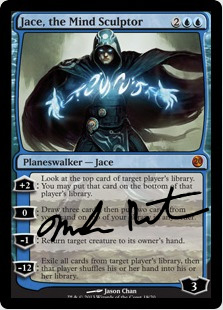
Players enjoy having me sign their Planeswalkers, with Jace being the most frequent request.
7) Mindslaver
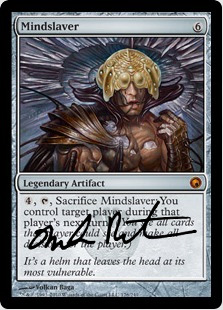
Whenever I'm asked my favorite card design, I tend to pick one of two. This is one of them, so players often ask me to sign it.
6) Doubling Season
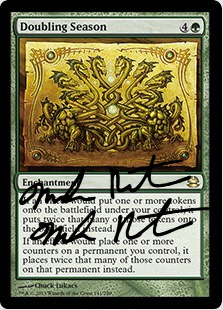
This is the other. I usually sign Doubling Season twice.
5) Other "Maros" (Multani, Molimo, Adamaro, Soramaro, etc.)
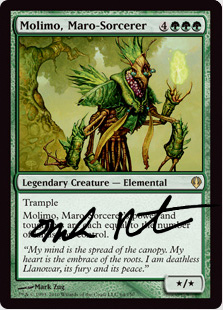
Between a few legendary 'maros and the cycle in Saviors of Kamigawa, I am often asked to sign various Maros.
4) Basic lands
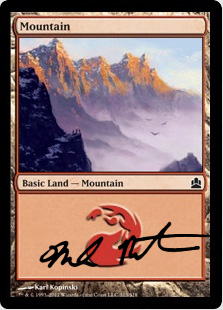
This seems to be the go-to when players just don't know what to have me sign. I guess basic lands are good because the cards can go in many decks.
3) Hornet Sting
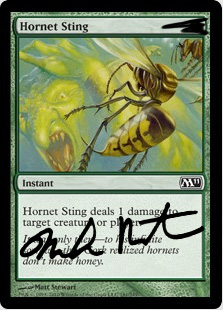
Hornet Sting has become my personal poster boy for "out of color pie" cards. Many players seem to think it's a hoot to have me sign my least-favorite card. Often when I sign one, I write a derogatory comment about it.
2) Look At Me, I'm the DCI
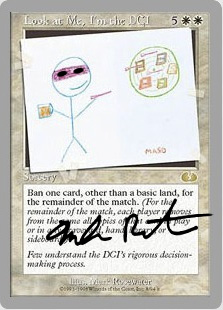
This card comes in at number two because I'm the artist (if we use that word real liberally). Whenever I sign one of these, I always put eyes on the blindfolded guy.
1) Maro
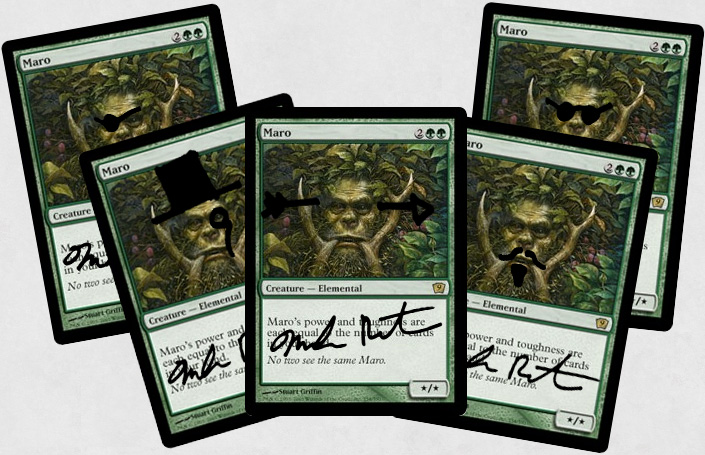
This card is named after me (it's the first two letters of my first name and first two letters of my last name, if you were unaware). Whenever I sign a Maro, I always draw a picture on the face. I have all sorts of different items I like drawing on the Maro face so there are many variations.
Top 8 Cards (Other Than Maro) Named after Designers
It's pretty public knowledge that Maro is named after me, but I am far from the only designer to have a Magic card named after him. What follows are my favorite Top 8. I should also note that this is what we call vanity cards (i.e., in-jokes referencing the people who make the game). We no longer do vanity cards, so all the examples come from early Magic.
8) Jayemdae Tome (Alpha)
When Richard first came to Wizards of the Coast to pitch a product, that product was not Magic, but rather Roborally. Peter Adkison, the company's co-founder and first CEO, said the company was too small to make a game like Roborally. What he could make was a small, portable game made using cards. That, of course would lead to Richard making Magic. The person who came with Richard at that first meeting was a man named J. Michael Davis. He would later go on to become one of the first Vice Presidents of R&D. As a tribute to him, Richard named a card in Alpha after him—the J.M.D. Tome (and yes, that is how it's pronounced).
7) Jalum Tome (Antiquities), also: Jalum Grifter (Unglued)
The Jayemdae Tome started a little trend where Tomes in the game got named after Magic designers. Jalum or J.L.M. Tome was named after Joel L. Mick, one of the designers of Antiquities, Mirage, and Visions. Joel would go on to be head designer and then later senior brand manager of Magic.
6) Emmessi Tome (Tempest)
Emmessi Tome or M.S.E. Tome was named after Michael S. Elliott. As you can see above, Mike has led more Magic sets than any other person on the planet save myself. During Tempest, I got this card named after him as a tribute.
5) Joven (Homelands), also: Joven's Ferrets, Joven's Tools (Homelands)
4) Mons's Goblin Raiders (Alpha), also: Mons's Goblin Waiters (Unhinged)
Mons Johnson was a longtime friend of Richard Garfield. He was well known for his love of goblins, so when Richard made Alpha he decided to create a famous goblin, Pashalik Mons, named after his friend. Mons's Goblin Raiders were the followers of Pashalik Mons.
3) Delif's Cone (Fallen Empires)
Don Felice was one of the original playtesters. He was on the design team that designed Mirage and Visions. He was friends with the East Coast Playtesters, so they decided to name a card after him in Antiquities. It was called Feldon's Ice Cane. Feldon Ice was an anagram of Don Felice. But the word "Ice" got dropped when the art came back without any ice. To make it up to him, the team later (in Fallen Empires) named Delif's Cone after him. Delif Cone is also an anagram of Don Felice.
2) Telim'Tor (Mirage), also: Telim'Tor's Darts, Telim'Tor's Edict (Mirage)
Elliot Segal was one of the designers of Mirage and Visions. One day, he was talking about Chicago Bears football player William "The Refrigerator" Perry. Elliot thought it would be cool if they each had a nickname of a household item. "Okay, Mr. Toilet," Bill Rose replied. The Mr. Toilet name stayed a running joke, so in Mirage, they designed a character named Telim'Tor, which is an anagram of Mr. Toilet.
1) Phelddagrif (Alliances), also: Questing Phelddagrif (Planeshift)
This card is an anagram of "Garfield PhD." In the early days, whenever there was any mention of Richard in any media, he was always referred to by our PR team as Richard Garfield, PhD. R&D also used to joke that at some point Magic would end up making a flying purple hippo. So for fun in Alliances, The East Coast Playtesters (see above) made a flying purple hippo and named it after Richard. (Back in the day, the designers did a lot of the naming for their own set.)
Top 8 Longest Card Names
What follows is the eight longest card names of English Magic cards. The number counts all letters, symbols and spaces. My contributions to this list are on the Un-cards, where I got to cheat in ways black-border could never follow.
7) (tie) Circle of Protection: Artifacts (32)
7) (tie) The Tabernacle At Pendrell Vale (32)
5) (tie) Erase (Not the Urza's Legacy One) (34)
5) (tie) Okina, Temple to the Grandfathers (34)
4) Infernal Spawn of Infernal Spawn of Evil (41)
3) Burning Cinder Fury of Crimson Chaos Fire (42)
2) The Ultimate Nightmare of Wizards of the Coast® Customer Service (64)
Top 8 Non-Evergreen Mechanics That Have Returned the Most Times in Standard-Legal Sets
Mechanics are a design resource that we have learned have value with reuse. Here are the eight mechanics that have been reused the most.
5) (tie) Convoke (2)
Convoke first appeared as the Selesnya mechanic in Ravnica. It then returned on three mix-and-match cards (cards that had two mechanics from different times in Magic mixed together) in Future Sight. Convoke returned for a second time just this year as the one returning mechanic in Magic 2015.
5) (tie) Flashback (2)
Flashback first appeared as one of the two major mechanics in the Odyssey block. It was then brought back for Time Spiral block, mostly in Time Spiral as a mechanic representing the past. It was brought back for the second time for Innistrad, the top-down Gothic horror set with a strong graveyard component.
5) (tie) Kicker (2)
Kicker first appeared as the major mechanic from Invasion block. It returned during Time Spiral block. The mechanic was brought back for a second time during Zendikar block, which was looking for a mechanic that allowed you to spend all the extra mana that came from having additional lands.
5) (tie) Morph (2)
Morph first appeared in the Onslaught block. It was brought back during the Time Spiral block, focused primarily in blue. It recently was used for the second time in Khans of Tarkir, where it highlighted the subterfuge of a warlord-strewn world.
1) (tie) Cycling (3)
This mechanic, originally designed for Tempest, first appeared in the Urza's Saga block. It returned in Onslaught, as the team was looking for a cycling-like mechanic. That was the first time a non-evergreen keyword mechanic had been reused. Next, cycling showed up in Future Sight at the end of the Time Spiral block. Cycling returned for a third time in Shards of Alara block, which used the mechanic to help smooth out card drawing to aid in making sure the players got the color of mana they needed.
1) (tie) Hybrid mana (3)
Hybrid mana first appeared in the Ravnica block. It was removed from the set for a while but was brought back when Brian Schneider, the lead developer of Ravnica, decided the set needed something that felt a little more innovative. Hybrid would first return in Shadowmoor, which was a block built around hybrid mana. Half of the cards in each booster were hybrid cards. Hybrid next showed up in Alara Reborn as a means to make cards that could go into one of two two-color combinations. Hybrid came back again when Magic revisited a favorite plane of the past in Return to Ravnica.
1) (tie) Scry (3)
Scry was created by Aaron Forsythe and first appeared in Fifth Dawn at the end of the Mirrodin block. Aaron designed the mechanic as a way to help players get better card flow. The mechanic has proved very useful for development and has returned three different times. First, it returned in Future Sight at the end of the Time Spiral block, where it played into the theme of "the future" (as scry is, flavor-wise, seeing into the future). It then returned in Magic 2011 as a returning non-evergreen keyword mechanic. All future core sets then followed the pattern of bringing back a non-evergreen keyword mechanic. Finally, during the development of Theros, scry was added as means to smooth out the draws, allowing all the interactions of Theros to happen more frequently.
1) (tie) Split cards (3)
Split cards were first created for Unglued 2, but eventually saw print in Invasion. They returned for the first time in Dissension at the end of the Ravnica block as gold cards. Split cards showed up again in Planar Chaos, for the first time with both cards being the same color—all of them red. Split cards showed up for a third time in Dragon's Maze, with a new ability called fuse, which allowed you to cast both of the cards on the split cards if you had the mana.
Top 8 Favorite Jobs I've Done at Wizards Other Than Designing Cards
One of the great things about my job is that not only do I get to design Magic cards and mechanics and sets and blocks, but over the years I've gotten to do many other cool things.
8) Judge

For many years, I was a Level IV judge. I ran the Feature Match area at the Pro Tours and was very active in judge certification.
7) Manager of the creative team
When I first became head designer, it came with a second job: overseeing the creative team. During my reign, the team did both the original Ravnica and Time Spiral blocks.
6) Moderator for the San Diego Comic-Con panel
For many years, I'd been attending San Diego Comic-Con. One day, I walked into Elaine Chase's office (Elaine is the senior brand manager for Magic) and asked if she would mind if I did a panel at Comic-Con. My original plan was for it just to be a small solo thing I did. But it quickly turned into a much bigger deal, and something I get to moderate every year. It's always one of the highlights of my year.
5) Story coordinator
For a small period of time, my good friend Michael Ryan and I were in charge of the Magic story—what you all know as the Weatherlight Saga (well, at least the beginning of it). We were in charge from Weatherlight through the middle of Exodus. As someone whose previous job was writing for television, I loved getting to craft Magic's story.
4) Video producer at the Pro Tour
For the eight years I attended the Pro Tour on Sunday, I was in charge of organizing the "show" side of the video productions. I worked with the commentators and advised the director where we wanted to take the camera next. This let me use many of the skills I had learned at college in communications school.
3) Movie consultant
I'm one of four Wizards people currently working with the producers and writer on the Magic movie. It's our job to make sure the movie represents Magic properly. I can't really say much else about it other than it's been a blast and I'm very excited by all the things I can't talk about yet.
2) Editor-in-chief of The Duelist

Somehow, in my spare time, I got to be the editor-in-chief of a magazine. I was very proud of all the issues published under my leadership by our amazing staff.
1) Magic spokesperson
A weekly column and podcasts. A daily blog and comic. Lots and lots of player interaction through social media. Tons of interviews. When I'm not busy making Magic, I'm talking about Magic, and it's one of my favorite parts of my job. I also believe it helps make me a better designer.
Top 8 Sets That Changed the Most From Where They Started
8) Khans of Tarkir

In the beginning, the set had four factions, not five, and the set wasn't about wedges at all.
7) Time Spiral
In the beginning, Time Spiral was all about time manipulation. It wasn't until we stumbled upon the past/present/future block plan that we started trying to find ways to communicate "past" in the first set. That led to us using nostalgia. And before we knew it, the nostalgia theme became a large part of the set's (and later, block's) identity.
6) Mirrodin
In the earliest version of Mirrodin, the creatures didn't have any metal in them because they were all transported from other worlds in order to fight in an arena—part of a three-block connected storyline that never came to be. The creative team took our basic idea but shifted many years into the future, where the people brought to the world evolved over generations into creatures with metal woven into their anatomy.
5) Tempest
The world of Rath was originally going to show off how dangerous it was by having poison as its main mechanic. But then R&D decided to excise poison from the game and that theme was stripped out of the set.
4) Ravnica
Originally, the set was going to split its multicolor between half normal gold cards and half hybrid cards, but the early playtest was too hard for R&D, which was a sign that we had to scale back.
3) Onslaught
For much of Onslaught's design, it didn't have morph or cycling, and the tribal theme was a tiny component. You can listen to my relatively recent podcasts on Onslaught (see below) to learn the whole story.
Episode 163: Onslaught, part 1 (13.3 MB)
Episode 164: Onslaught, part 2 (14 MB)
Episode 165: Onslaught, part 3 (13.2 MB)
Episode 167: Onslaught, part 4 (13.0 MB)
Episode 168: Onslaught, part 5 (12.9 MB)
Episode 169: Onslaught, part 6 (15.6 MB)
2) Scars of Mirrodin
For many months, Scars of Mirrodin was going to be New Phyrexia and the players were going to go through the entire block before they learned that New Phyrexia used to be Mirrodin. We realized that we had skipped over an interesting part of the story and backed up.
1) Innistrad
For much of the early planning, the fall set of 2011 was not a Gothic horror set. That set was going to be a single large set in the spring of 2012 (what would later become Avacyn Restored).
Top 8 Is Enough
I hope you enjoyed my little dip into trivia today. As always, I would love to hear your feedback through my email or any of my social media (Twitter, Tumblr, Google+, Instagram).
Join me next week, when we take a trip around the Worlds.
Until then, may you make a few Top 8s of your own.
"Drive to Work #176—Tales from Europe"
This podcast is a spiritual sequel to a podcast called "Tales from the Boat," where I shared some Pro Tour stories from the early days. This podcast focuses on a few early Pro Tours held in Europe.
"Drive to Work #177—10 Things Every Game Needs: Goal"
This is the first podcast in a now ongoing 10-part series called "10 Things Every Game Needs," based on my article and podcast of the same name. Each podcast, I go in depth on one aspect. For the first one, I talk all about the needs of a game having a goal or goals.
- Episode 177 : 10 Things Every Game Needs: Goal (16.0 MB)
- Episode 176 : Tales from Europe (23.5 MB)
- Episode 175 : Exploratory Design (19.5 MB)
- Episode 174 : Meeting Expectations (15.0 MB)
- Episode 173 : White-Blue (14.2 MB)
- Complete Drive To Work Podcast Archive

